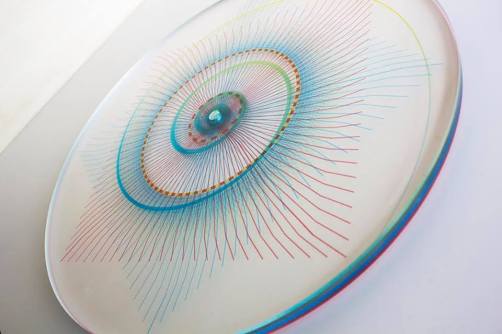
At the Sound System Outernational Symposium on July 2nd, 2016, I had the opportunity to participate in panel dedicated to sound system aesthetics chaired by Prof. Julian Henriques. The panel featured poet and playwright Kadijah Ibrahim, accompanied by dancer and artistic director of Phoenix Dance Company David Hamilton and legendary Leeds toaster KD Ranks ( of Maverick Sound, you can hear a tape of their 1985 clash with Saxon here), alongside designer and selector Liv Santos Holm, and creative practitioner SuhailK .
Over the coming weeks and months we will be producing a series of texts on the basis of panels and workshops at the Symposium in July.
The panel was opened by Kadijah, David and KD Ranks. Kadijah’s talk offered a historical perspective on the importance of sound systems in shaping the Caribbean and Black British experience in the United Kingdom, presenting a wealth of images documenting the role of sound systems in building community and Black identity in the north of England.

Kadijah also explored some of the continuities between the work of toasting or deejaying and the Black British poetry tradition, citing poet Linton Kwesi Johnson and sharing some of her own work (you can see an excerpt from the talk, including a recording of Kadijah’s poetry here). This was followed by performances from KD Ranks and David Hamilton, showcasing the art of toasting/deejaying and dance respectively. Each of these art forms associated with sound system culture is expressive of the unique relationship between audience and performer specific to the sound system tradition, each inextricably linked in the production of shared space. Showing this through performance also generated an embodied sense of some of the sounds and sights of the culture historically and in the present day.
After this, Liv Santos Holm showcased her project Resonate to This, a mixed media project aimed at visualizing the sonic techniques and auditory spaces of sound system culture and dub music specifically, using print, installations and projected visuals, as well as a theoretical framework including Marshall McLuhan and Lee Scratch Perry. Liv is also a selector under the name Liv Pa Mars and has designed a range of fliers for sound system and reggae events in Oslo, Norway. Presenting her work as a visual live mix of elements from the Resonate project, Liv discussed the impact of electricity and recorded music on shared experience and explored the liminal spaces of aesthetics and perception in sound system culture that bridge sound, touch, and sight.
My own contribution was a reading of sound system aesthetics through the lense of philosopher Jacques Ranciere’s idea of a distribution of the sensible, that is, the structures that determine what can be seen, heard, and felt in a particular society. For Ranciere, political struggle is the process by which those excluded, those who are made invisible and inaudible, fight for a redistribution of the sensible in which they can be recognised and heard. The specific techniques developed through sound systems for achieving this kind of redistribution were illustrated through the work of Nadine Robinson , a New York based artist who incorporates elements of sound system culture into her art as a means of cracking open the closed space of the art gallery from the inside:
In Jamaica, the sound system is a major part of urban culture. The sound system is the pied piper, a way of participating and having a dialogue with your community: my way of having a dialogue with my community, the art world, as well as not excluding people that were close to me, my family and my friends, and the place I identified with, I made this 11 by forty five foot sound system with speakers arranged in a diagram of Michelangelo’s Sistine Chapel, The Last Judgement (…) it’s a sound piece, and altar, an environment. (Nadine Robinson speaking at the High Museum of Art)
The final speaker was artist SuhailK, based in Manchester. Suhail has been producing art as part of a collective named WeDoDub, dedicated to exploring the visual application of dub techniques through collage and found objects, and exploring the legacy of King Tubby through visual arts. A long-term stalwart of Manchester’s arts and culture community, Suhail has been actively exploring the history and visual profile of the influential UK-based Blood and Fire label. Suhail’s talk offered insight into mixing, re-mixing, the act of “dubbing” an image, the juxtaposition of seemingly mismatched elements (compare the use of “found sound” in dub music) and ways of experimentally moving the legacy forward in visual terms.
The panel converged on two distinctive features of sound system aesthetics: the deep and complicated relationship between different media and modes of perception in the creating of sound system aesthetics, and the central role played by collective production, whether in terms of sound systems as a focal point for building solidarity and shared oppositional identities or in its blurring of the distinctions between performer, audience, and technician.
The Jamaican tradition of sound systems has generated insights and experiences, animated social movements for liberation across the world, helped foster resilient and creative communities, and has not only eased the pain of migration and marginalisation, but served as a vehicle for marginalised and migrant communities to take reconfigure and transform social space. But the process involved is not always approached with the seriousness which these achievements merit, whether as art, technique, activism, or experiment. As such, we need to continue exploring and developing the unique aesthetic language of sound system culture and reggae, both to deepen our understanding of and pay our respects to the tradition and those who came before, but also to find new ways of applying these techniques to confront the aesthetic and social challenges we face today.
